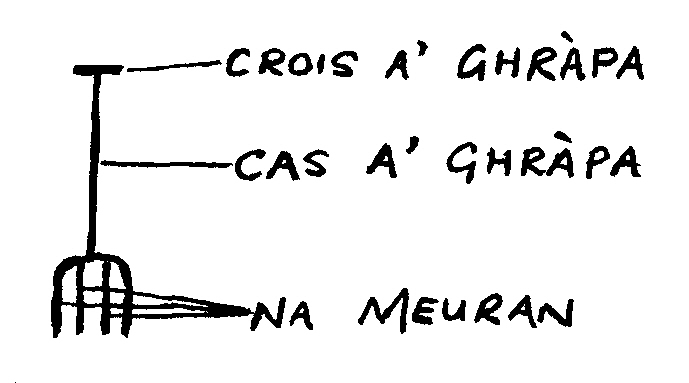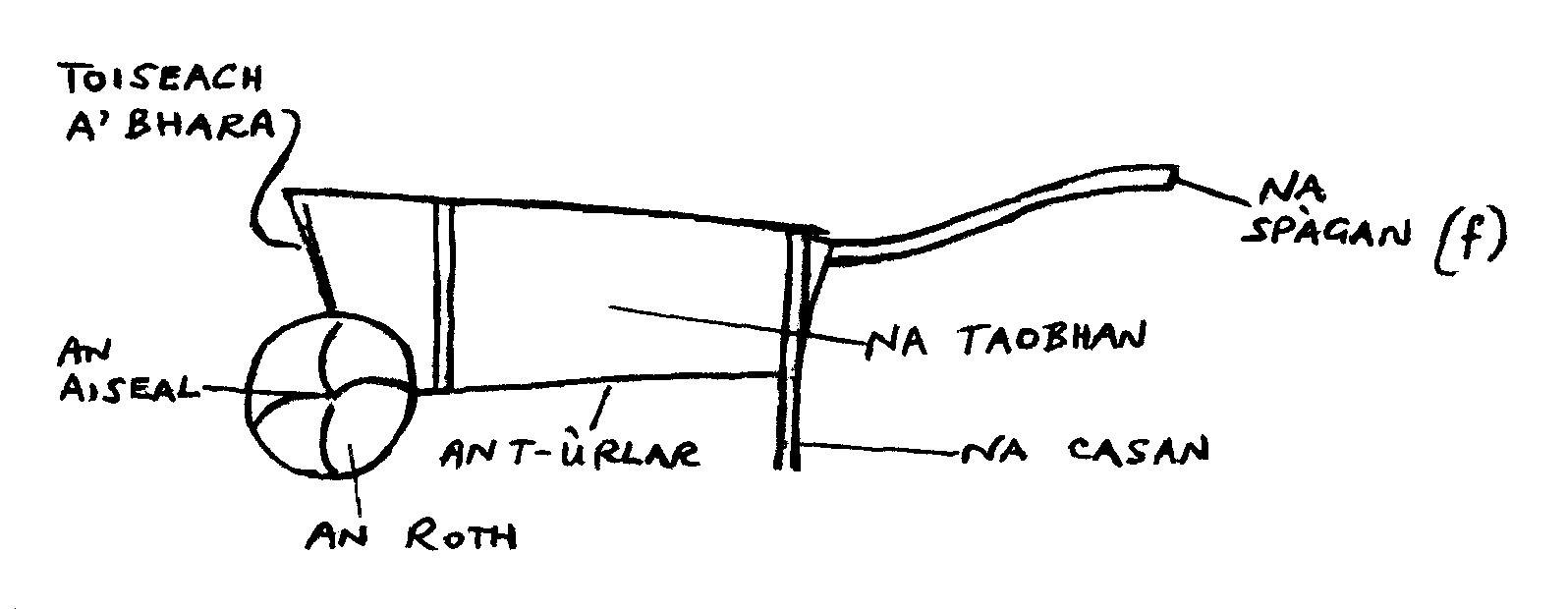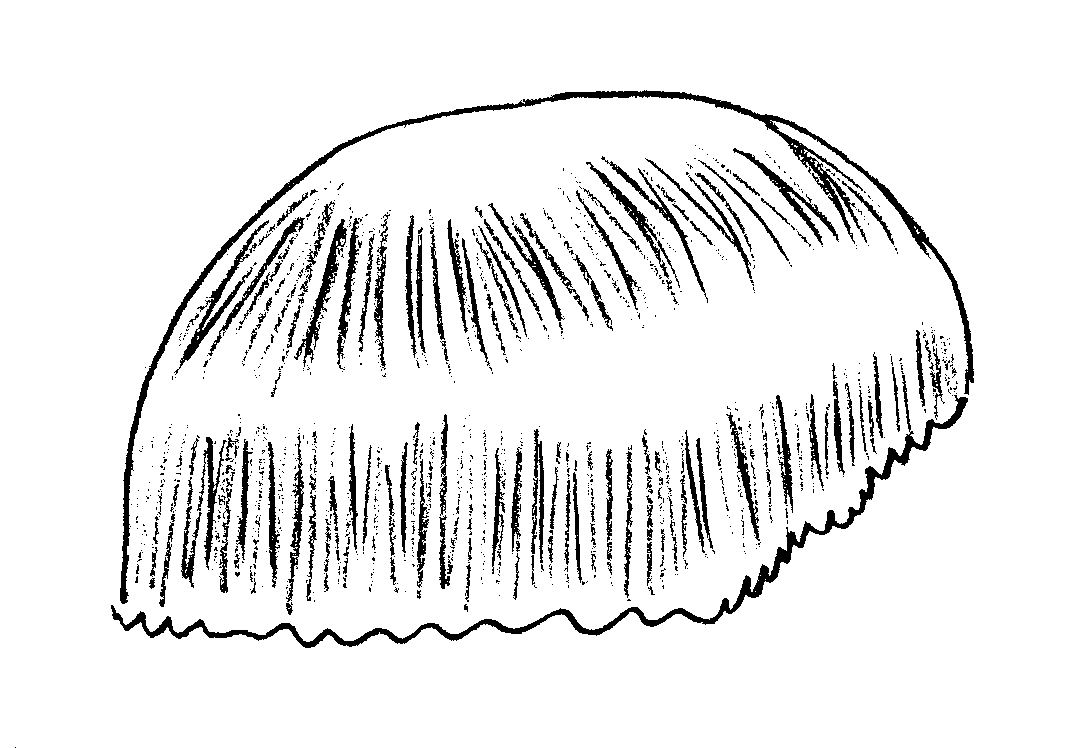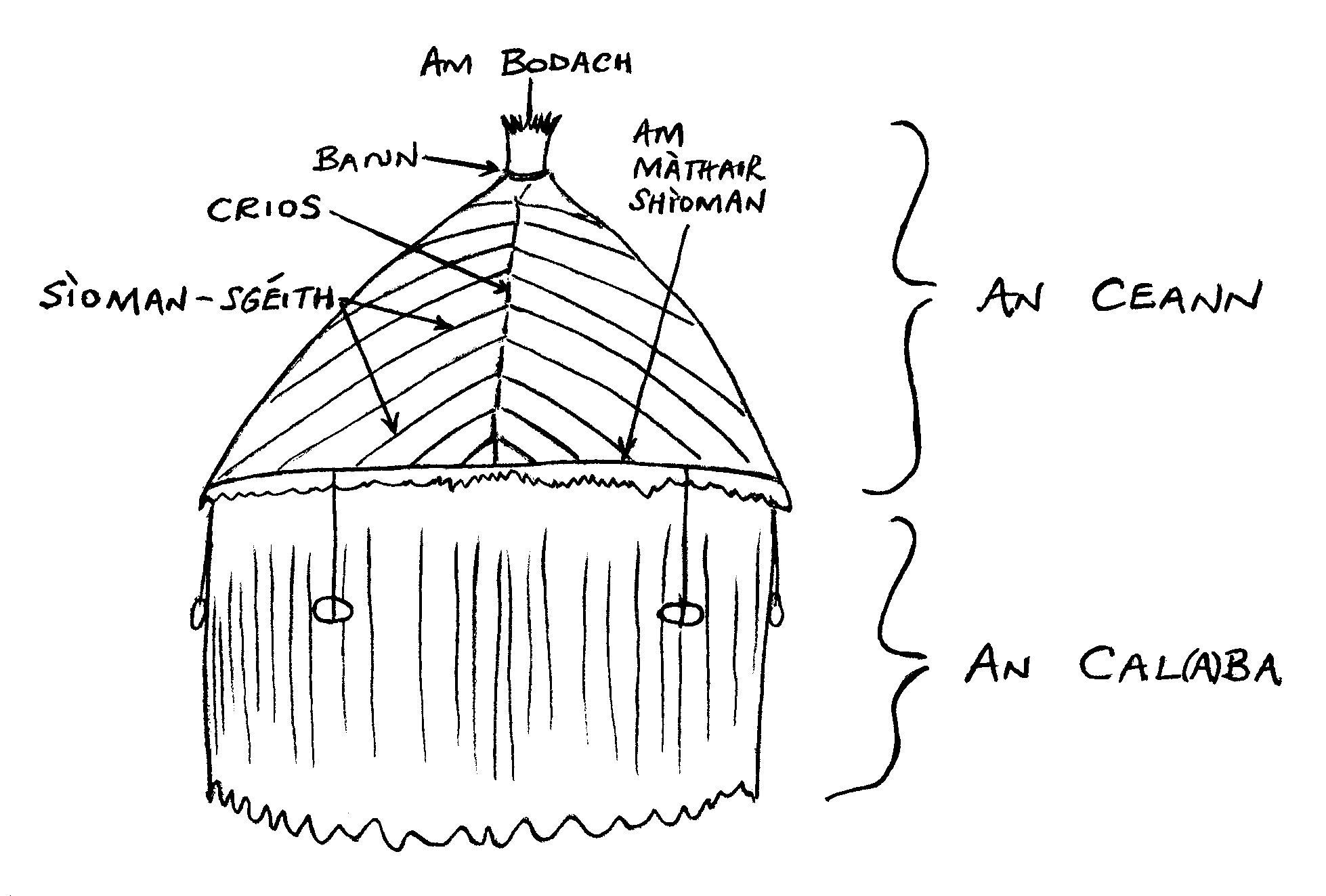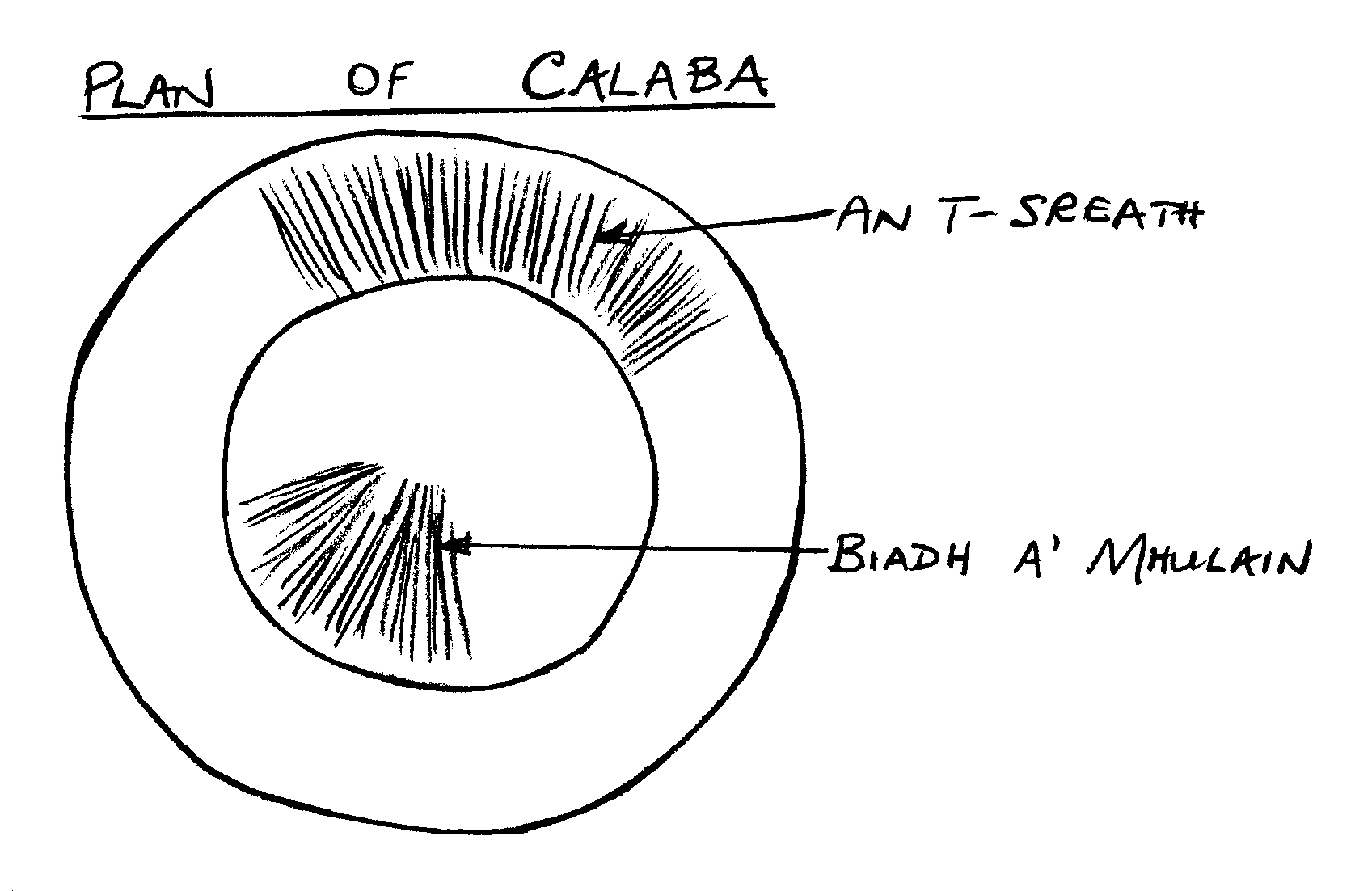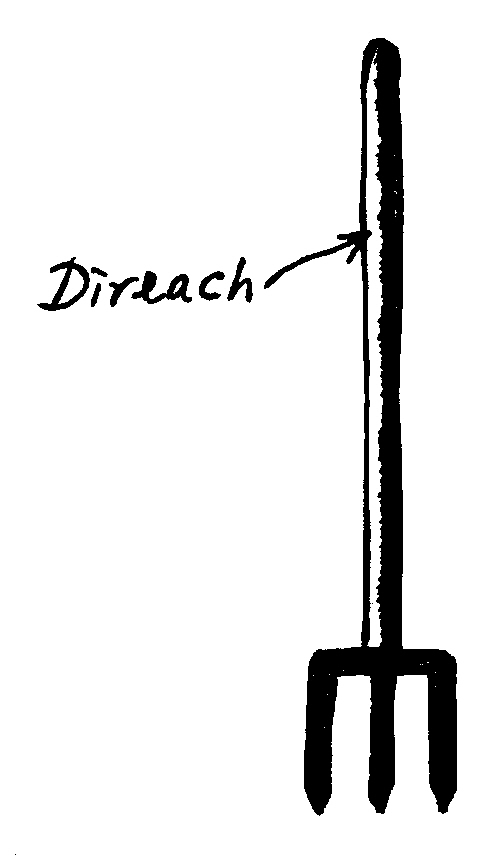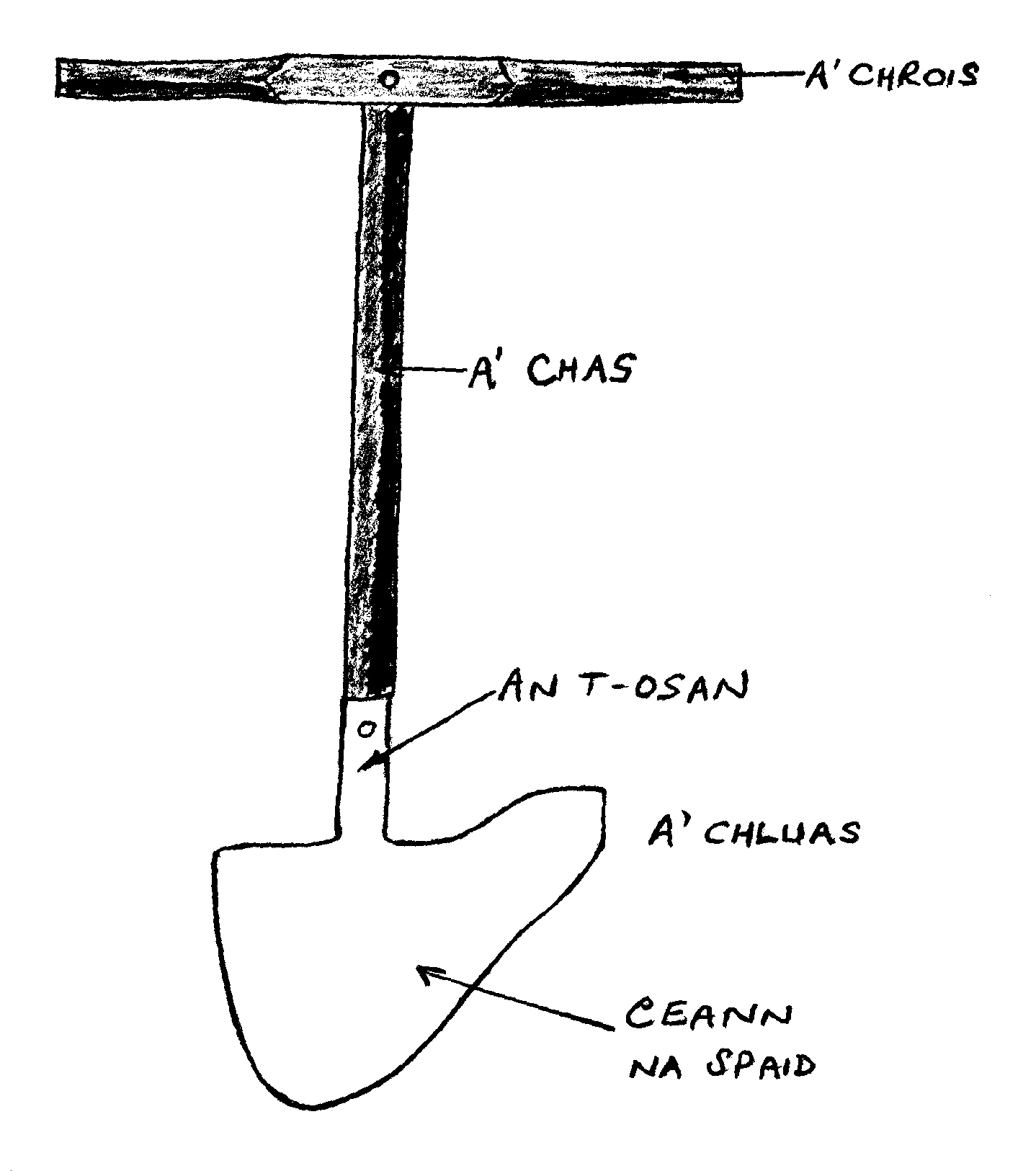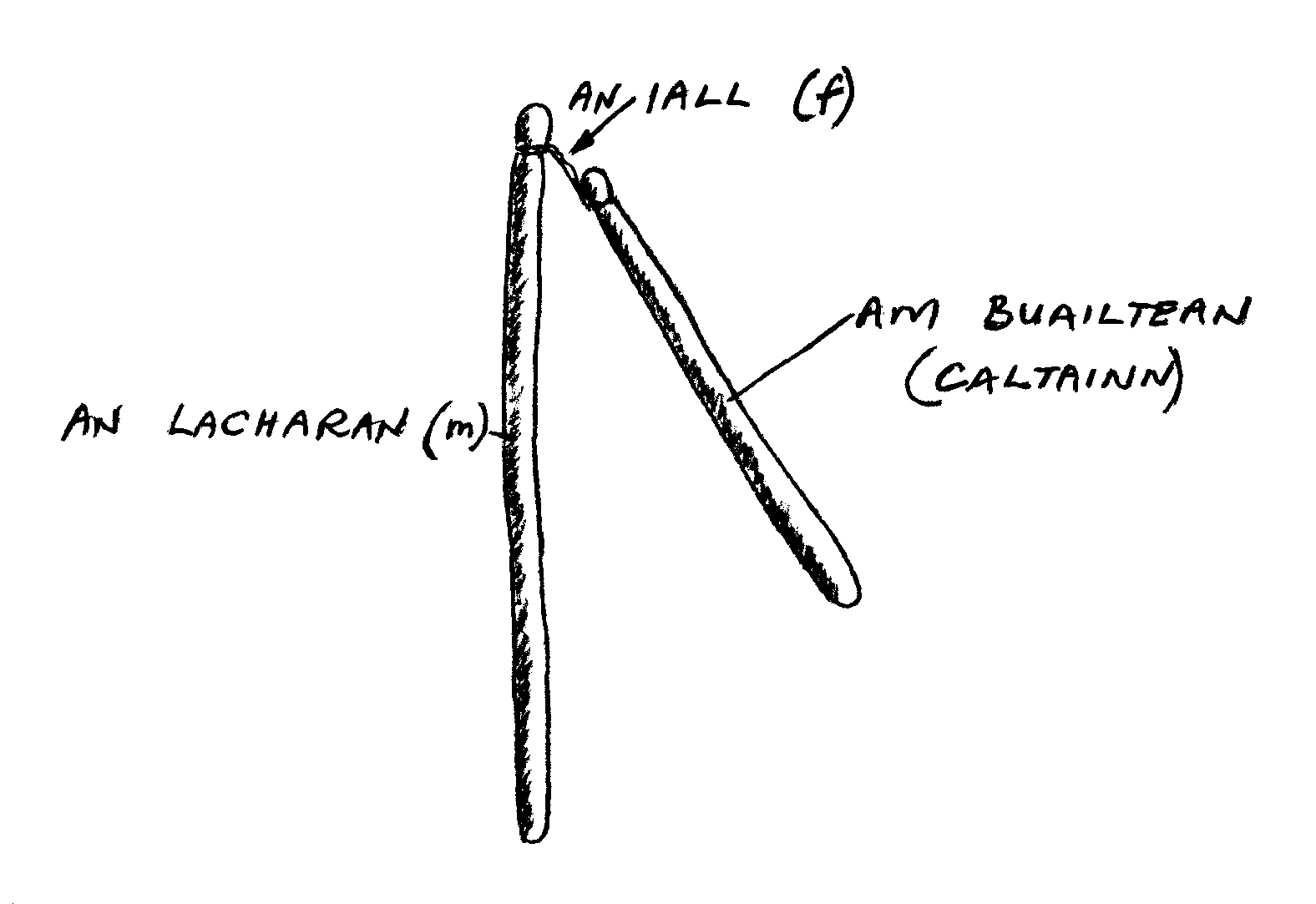| 1. Land division and allocation |
| (a) Specific portions or allotments into which arable land is divided |
| sgrìob (f) | furrow. |
| drilleadh (f), drillich (pl) | drill. |
| iomaire (m), iomairean (pl) | strip. |
| gàrradh-cal | vegetable plot. |
| gàrradh-buntàta | potato plot. |
| feannag (f), feannagan (pl) | lazy-bed. |
| druim (m) | ridge. |
| gàrradh (m) | walled field (pìos beag de ghrunnd). |
| achadh (m) | open field. Achadh-coirce. Achadh-eòrna. Achadh-seagail. |
| (b) Various types of arable land |
| grunnd gun chinneas | fallow ground. |
| grunnd falamh | fallow ground. |
| falamh | Fallow not practised much in Tiree – crofts too small. |
| talamh àitichte (m) | ploughed land, cultivated land. |
| talamh àiteach (m) | land suitable for cultivation. |
| talamh glas (m) | unploughed land. |
| talamh làidir (m) | unploughed land. |
| (c) Actual dividing and allocating of land, e.g. casting lots |
| [crann] | a’ dol a chrann, a’ cur a chrann – casting lots. Casting lots in Barrapol, Tiree was used most commonly in the dividing-up of seaweed on the shore amongst the township crofters. Two bodaich would draw aside from the group. One felt his pockets for objects (e.g. a pipe, a knife, a penny, etc.) and the other decided which lot each object represented. Then the first bodach held the objects in the palm of his hand for picking. Never more than ½ doz lots. |
| [crìochan] | boundaries. Crìochan of lots marked out by furrows with ceaba, or by tangles (stamhan). |
| a’ togail chrìochan | constructing boundaries. |
| a’ càradh chrìochan | mending or maintaining boundaries. |
| a’ tomhas chrìochan | marking boundaries (done by pacing). |
| (d) Land owned or held under leases of various duration |
| croit (f), croitean (pl) | croft. |
| fearann (m) | farm. |
| tac | tack. |
| fearann a’ diùc | the state on Tiree. |
| an oighreachd | the estate on Tiree (uaireanan). |
| caiticheann (m) | common grazing. |
| feurach (m) | grazing. Feurach-cruidh. (Dh’fhaodadh e a bhi air a’ chaiticheann [q.v.] no air a’ chroit-fhéin.) |
| machaire (f) | sea-meadow. |
| sliabh (m) | hill-pasture. |
| 2. Harness of a horse |
| (a) The harness of a horse as used in the performance of different tasks |
| (b) Different parts of the harness for carting |
| bit (m), bitichean (pl) | bit. |
| stàg | bar attached to bit by chain and situated below jaw so as to control horse. |
| srian (f), srianan (pl) | reins (ropa caineaba – hemp). |
| srònach (f), srònaich (pl) | strap across nose (leather). |
| smeachan (m), smeachain (pl) | fine string going round jaws to keep the headstrap from moving over the ears. |
| claigeann (m), claigeannan (pl) | headstrap, going round back of head (leather or rope). |
| na blinders | blinders (only used in Tiree when driving a trap or machine). |
| sùgan (m), sùgain (pl) | collar (connlach air figheadh taobh-a-staigh agus learach taobh-a-mach). |
| na hems | hames (tied at top with hemp). |
| a’ bhois | flat part on collar before coming to hooks on hames. |
| hamestrap | strap / chain (generally hemp) joining hames together. |
| guailleachan (f), guailleachain (pl) | shoulder slings or chains (traces). |
| srathair (f) | saddle. |
| driomal (m), driomalan (pl) | chain in saddle groove. |
| am belly-bann (m) | belly-band (hemp). |
| a’ bhriogais (f) | collectively parts round hindquarters and tail. |
| (c) Different parts of the harness for ploughing or harrowing |
| sìnte (f), sìnteachan (pl) | backstrap and chains going back to the swingle trees. |
| na gaidheachan | guys (for preventing horses from separating too much in two-horse ploughing). |
| 3. Carts |
| (a) The common farm-yard cart |
| cairt (f), cairtean (pl), cartach (gen) | common farm-yard cart. |
| cairt-chopaich, cairtean-copaich (pl) | couping cart. |
| càrn (m), càrnan (pl) | a cart without sides or a back, for carrying timber. |
| (b) Different parts of a cart |
| 1. Body |
| bocsa na cartach | body of cart. |
| na trims | sole-beams or two main beams lengthwise. |
| spàrr-thoisich, spàrran-toisich (pl) | front cross-beam. |
| spàrr-dhéiridh, spàrran-deiridh (pl) | rear cross-beam. |
| slot (m), slotaichean (pl) | other cross-beams below body, and between front and rear ones. |
| ùrlar na cartach (m) | bottom of cart. |
| taobhanan (m) | side boards. |
| beul na cartach (m) | gunwale (a’ dol mu’n cuairt na cartach air fad, mar bhàta). |
| deireadh na cartach (m) | dropdown back-board for discharging. |
| toiseach na cartach (m), toiseachan nan cairtean (pl) | front-board on which driver sits. |
| plòtan (m and f), plòtain (pl) | chocks (separating trams from axle). |
| cìoch an roth, cìochan na roi | [sic] [pl] hub. |
| 2. Trams |
| 3. Wheel and axle |
| roth (m), roithean (pl) | wheel. (Not “rothan” in Tiree.) |
| aiseal (f), aisealan (pl) | axle. |
| an cearcall (m) | iron tyres (hoop / ring). |
| na fullys | felloes. |
| cìoch an roth | wooden hub. |
| 4. The plough |
| (a) Different kinds of ploughs |
| crann Gallda | all iron, 2 horse plough with steel mould board (sgiath). |
| crann Gàidhealach | all iron 2 horse plough with cast iron mould board (sgiath). Had wooden handles locally made. |
| [plough] | Both metal swing ploughs not controlled for depth. Driver had to control depth. |
| (b) Parts of a plough in detail |
| an tarraing (tarraing a’ chruinn) | the part to which main swingle tree is attached. |
| bonn a’ chruinn | the head to which the sock is attached. |
| sgiath (f), sgiathan (pl) | the furrow board or mould board. |
| druim a’ chruinn | the part to which furrow board and earth board are attached. |
| barr an t-suic | the point of the sock. |
| sgiath an t-suic | the “winged” part of the sock. |
| osan an t-suic | where the sock fits on to plough. |
| coltaire (m), coltairean (pl) | coulter. |
| spàg (f), spàgan (pl) | stilts. |
| soc (m), socan (pl) | share. |
| smuiseal (m), smuisealan (pl) | hooking device between “druim a’ chruinn” [q.v.] and “an tarraing” [q.v.]. |
| 5. Harrows and swingle trees |
| (a) Different types of harrows |
| cliath (f), cliathan (pl) | harrow. |
| stoc (f), stuic (pl) | 3 or 4 main beams, always wooden. Made of ‘giuthas geal’ or larch when being used for light sandy soil. Made of ‘darach’ when being used for heavy, clay soil. |
| fiaclan na cléith | tines (sia fiaclan anns a h-uile stoc). |
| ludagan nan cliathan | hooks joining two harrows together. |
| (b) Swingle trees |
| greallag (f), greallagan (pl) | swingle trees. Swingle trees in two horse ploughing / harrowing composed of three main components: 2 ‘greallagan’ (nearer horses) and 1 ‘amall’ (nearer plough / harrow – bigger and heavier). But if only one horse used, then one ‘greallag’ used. |
| 6. Spring work |
| (a) Fertilisers and fertilising |
| 1. Fertilisers |
| innear | manure. |
| innear-each (f) | horse manure. |
| innear-cruidh | cow manure. (Chan e …-chruidh.) The best manure was that in a 2-3 year old “Dùnan” on which grass would be growing. |
| innear-chal (f) | pigeon manure. Obtained from caves in Ceann a’ Bhara. An innear as treasa. Bha i tioram mar mhin, agus bha feadhainn a’ cumail a-mach gum b’i an innear as fhèarr – na bu bheairtiche. |
| innear Ghallda | artificial manure (imported). |
| Seaweed |
| barr dearg | top or flower of tangle (Laminaria digitata). Separates from the actual tangle-stock (stamh) in April/May. Then it comes ashore and commences rotting in the sun. Rotting forms it into a jellied mass known as “bruig”. |
| bruig (f) | form of barr dearg [q.v.] collected for fertiliser. |
| cìob (f) | [kind of seaweed.] Reddish in colour and most often found in October. Grows on actual rock. Takes a long time in rotting due to cold weather (winter-time). Good for potatoes. |
| feamainn dhubh (f) | bladder wrack (Fucus vesiculosus). Grows close inshore and has to be cut from the actual rock. Not so fine as “a’chìob” [q.v.]. Tha i anabarrach math airson talamh-buntàta cuideachd. |
| caraichdein (f) | carrageen (Gigartina stellata). Collected in August. Car bog, spongy. Car buidhe cuideachd. |
| duileasg (f) | dulse (Rhodymenia palmata). Car buidhe agus dearg a-mach a season. Bha caig [sic] duileasg ’nad bhial dìreach mar a fhuair thu an tràigh i. |
| feamainn chìoran, feamainn chìreadh | channel wrack (Pelvetia canaliculata). Even spongier than caraichein [sic – caraichdein above] [q.v]. Dorcha-buidhe. Bha iad ’ga truisneachadh airson leigheas crodh air an robh tart. Gheobhadh tu i air na creagan mar a bha an làn ìseal. |
| sgeannagan (m) | [kind of seaweed.] Buidhe. ’Ga fhaotainn mar a bha an làn ìseal aig am [sic] sam bi de’n bhliadhna. ’Ga chaigneadh ’nad bhial cuideachd. Table-knife in shape. |
| caragan (m) | [kind of seaweed.] Ri ’chaigneadh. Cha mhór nach robh e dubh. |
| slamhcan (m) | [kind of seaweed.] (Enteramorpha intestinalus). Sleamhainn. Makes pudding – not very good. Green weed / fungus on rock. Brackish water. |
| 2. The actual work performed, e.g. transporting seaweed/manure to field |
| a’ feamanadh (verbal noun) | the act of transporting seaweed from the shore (ann an cairt). |
| a’ cur fodha na feamainn | the act of putting seaweed into furrow (le forc no gràpa). |
| 3. Implements used for lifting, carrying and spreading manure or seaweed |
| gràpa dìreach | graip used for spreading of both ‘innear’ and ‘feamainn’ on field before ploughing. Sometimes known as ‘gràpa cartach’. Crois a’ ghràpa – handle. Cas a’ ghràpa – shaft. Na meuran (always 4) – prongs. (Chan e “meòir” ann an Tiriodh.) |
| gràpa cartach | [See gràpa dìreach.] |
| gràpa crom | graip - air a uisneachadh air uaireanan airson ’ga toirt as a’ chairt. Na’s fhaide na gràpa dìreach [q.v.]. |
| bara (m) | barrow. Toiseach a’ bhara. An aiseal. An roth. An t-ùrlar. Na taobhan. Na casan. Na spàgan (f) (spàg – sing.). |
| (b) Turning and tilling the soil |
| 1. Implements used for turning or tilling the soil |
| ceaba | ordinary garden spade. |
| gràpa | fork. |
| 2. Parts of the implements used |
| 3. Words used in connection with tilling the soil, e.g. digging |
| a’ gearradh sgrìob | digging a furrow (le ceaba, nan robh luachair ’sa leithid ann). |
| an druim | first two furrows when starting to plough, face to face. Dheanadh iad druim le chéile. Daonnan nuair a bhiodh tu a’ treabhadh. |
| claise (f), claisean (pl) | between each ploughed section. |
| (c) Seed planting |
| 1. Names of seeds planted and words used for sowing or planting them |
| coirce beag | native to Tiree – only type of oats to grow on sandy soil. |
| coirce mór | other forms of oats such as “sandy oats”, “yielder”, “onward”, etc. Imported types. Used for grinding. |
| eòrna dà shreath | used as malting barley and for feeding. |
| eòrna ceithir sreathan (or eòrna mór) | ’se sin a bu mhotha a bha iad a’ cur an Tiriodh. Also for feeding and for making barley bread and barley porridge – brochan. Also used for malting. |
| eòrna mór | [See eòrna ceithir sreathan.] |
| seagal | rye. Used for feeding. Only stuff that would grow well on sandy soil. |
| 2. Names of any special sack, basket etc. used for carrying seed when sowing or planting |
| peall (f), peallan (pl) | sack formed around neck and shoulders from a blanket. |
| 3. Names of any special implement used for planting |
| [dibble] | Dibble used in Tiree. |
| 7. Summer work |
| (a) Cleaning and weeding potatoes |
| a’ glanadh a’ bhuntàta | weeding and cleaning (le làmhan). |
| a’ cur ioma | earthing (ridging them up, putting soil up onto ridges). |
| “hough” (f), houghaichean (pl) | hough. |
| (b) Thinning and weeding other crops |
| tanachadh | thinning. Tanachadh an tuairneip – thinning turnips (act of). (Also applicable to carrots.) |
| an ath-chuir | the transplanting of cabbage (planted from seed). |
| 8. Autumn work |
| (a) Hay making |
| 1. The implement used for (a) cutting (b) raking and turning (c) lifting and stacking |
| corran (m), corrain (pl) | sickle. |
| speal (f), spealan (pl) | scythe. |
| clach-speal, clachan-speal (pl) | sharpener. |
| ràsal (m) | hay rake. |
| forc (m), forcanan (pl) | hay fork. |
| 2. Name the parts of the implements mentioned |
| [speal] | An t-iaruinn. Gaidh. Na h-òrdagan. An crann (snathe). American snathe (below) used. Previously Scots snathe used (forked type) |
| seòl na speal | piece of canvas mounted on a wire behind blade at snathe to ensure that all grass was swept forward. |
| 3. Various stages of hay-making |
| a’ spealadh | scything. Speal mi. |
| a’ gearradh | cutting. |
| a’ tionndadh | turning. |
| a’ sprìodadh feòir | spreading and leaving hay light (airing) (le forc). |
| a’ tioramachadh feòir | drying. |
| rucannan-achaidh | hay-cocks. |
| a’ deanamh rucannan | stacking. |
| (b) Corn cutting and securing |
| 1. Implements used for cutting, raking, binding, lifting into stacks etc. |
| speal | |
| ràsal | |
| forc | |
| 2. Bands (for tying corn), sheaves, stooks etc. |
| bann (m), bannan (pl) | bands for sheaves. 8, but more usually 10 sheaves in each stook (adag) in Tiree. Reef knot for sguaban-coirce. Bann-eòrna (at sguab centre) for sguaban-eòrna. |
| a’ ceagal | [sic] tying. |
| 3. Stack making (in yard) |
| làrach a’ ruca | stone foundation (hay). Only in damp clay ground. Wooden tripods only used in the field – i.e. with rucannan-achaidh [q.v.]. |
| làrach a’ mhulain | stone foundation (corn). Only in damp clay ground. Wooden tripods only used in the field – i.e. with rucannan-achaidh [q.v.]. |
| ruca (m), rucannan (pl) | haystack (rick). |
| ruca-achaidh | small haystack in field [(wooden tripods used).] |
| ruca mór | large haystack in stackyard (anns an iodhlann). |
| prapag (f), prapagan (pl) | hay coil (mun do rinn iad rucannan). |
| mulan (m) | cornstack. |
| 4. Methods of carrying or transporting corn from field to corn yard |
| By cart |
| Then by |
| [slide feòir] | rig lifter (flat wooden slide). Mu naoi traighean (troighean) a dh’fhad agus sia traighean (troighean) a liad. Bha “trims” ann mar gum biodh air cairt, agus dà roth bheag. Air a tarraing le each. |
| Then by |
| forc-feòir | hayfork. |
| and |
| rasal | hayrake. |
| [corn] | Corn: 8 or 10 sguaban (sheaves) – 1 adag (stook); 10 adagan – 1 stuca; 8 stucannan – 1 mulan. |
| [ruca] | haystack in yard. Na casan (cas sing.) (4 altogether). Clachan. The horizontal rope (in the form of a spiral from the top of the ‘ruca’) has no special name, but its placing on a stack is known as ’ga shiomanachadh. |
| cruach (cruach feòir) | hay, oblong with rounded hipped ends. |
| sgian-fheòir | for slicing sections of stacks, esp. cruachan [q.v.]. Done vertically like a saw. |
| mulan | corn-stack in stack-yard. An ceann (thatched with seileasdair (iris) or [sic]: – Am bodach (½ doz sheaves). – Bann. – Crios. – Sìoman-sgéith. – Am màthair shìoman. An cal(a)ba. An t-sreath (outer row of sheaves). (Ears of adag to centre.) Biadh a’ mhulain (inner row of sheaves). |
| [calaba] | [See mulan.] |
| (c) Potato lifting and storing |
| togail a’ bhuntàta | [potato lifting.] |
| 1. Implements |
| gràpa-buntàta | Dìreach (cas a’ ghrapa [sic]). |
| 2. Sack, creel, barrow etc. used for carrying potatoes in field and to steading |
| [poca] | Potatoes put into a poca. |
| 3. Where potatoes are kept or stored |
| polag (f), polagan (pl) | potato pit. About 3' deep, 3' wide, up to 20' in length, 2' high (above ground level). Potatoes covered with layer of hay. Then covered with “ùir”. Then covered over by “sgrothan”, which had been cut with a “lair-cheab”. Better if potatoes were allowed to breathe as they sweat – toll beag no dhà mura biodh reothadh ann. Ma bha coltas reothadh ann, dh’fheumadh tu an dùnadh. |
| 4. Potato diseases |
| (d) Other crops (Lifting and storing) |
| 1. Implements used for lifting |
| clipeadh na’ tuairneip | cutting leaves from turnip (done with a scythe blade or “sgian thuairneip”). |
| 2. How and where crop is stored |
| sabhal (m) | |
| iothlann (f) | |
| 3. Diseases/insects which attack the particular crop(s) |
| fochan (m) | affects young crops of oats, barley, etc., which start wilting away before they mature. Cure to roll over with a heavy roller. (Only occurs in clay soil.) |
| toranach (m) | affects crops when growing. |
| [insects] | No insects in stackyard or barn. Only weevils but don’t diminish value. |
| finneagan an fheòir (f) | [weevils?] |
| coirce-madaidh | smut. Oats go black like soot with a fungus disease. Must be dressed with mercury solution to kill it (but not with feeding oats). Soaked in fermaldihide [sic] [formaldehyde?] nowadays. |
| cnoidheag (f), cnoidheagan (pl) | maggot in turnips. |
| 9. Winter work |
| (a) Land drainage |
| 1. Drains, ditches etc. |
| dìgean (f) | ditches. |
| dreanaichean (f) | drains. |
| 2. Implements used |
| spaid mhór | rutting spade. A’ chrois. A’ chas. An t-osan. A’ chluas. Ceann na spaid. |
| grapa crom | [sic] to haul turf out. An grap [sic] fhéin. An t-osan. Cas a’ ghrap [sic]. |
| (b) Potato cutting for seed |
| 1. Instruments used |
| sgian | |
| sùilean a’ bhuntàta | |
| 2. Different kinds of potatoes |
| buntàta luath | early potatoes. |
| buntàta anmoch | late potatoes. |
| buntàta ruadh | Orkney reds. |
| (c) Corn threshing |
| 1. Implements used |
| an t-suirsde (f), suirsdeanan (pl) | (An ‘r’ is often sounded in Tiree.) An iall (f) (de chraiceann caorach – the ‘iall’ was made of ‘sùgan’ in the distant past). Am buailtean (caltainn). An lacharan (m), lacharain (pl). |
| 2. Threshing |
| a’ bualadh | threshing. A’ bualadh arbhair. |
| dannsa na suirsde | manipulating the actual flail. |
| a’ spoth an t-sìl | separating the straws from the seed. |
| (d) Grain winnowing |
| a’ càthadh | [grain winnowing.] |
| 1. Devices used |
| fasganadh (f), fasganadhan (pl) | vessel used for winnowing seed (airson a’ mhuill a chur air falbh). 18" in diameter and fairly shallow (c. 2") with a solid bottom of sheepskin (wooden). |
| criathar (m), criathair (pl) | deeper than “fasganadh” [q.v.] – c. 4" and with a perforated sheepskin bottom (done with a red hot knitting needle or ‘dealg’). Airson fras a’ sgeallain a chur as an t-sìol. (Wild mustard – finer than oats or barley.) |
| 2. How constructed and materials used. Winnowing |
| 10. Permanent structures/buildings for storing crops |
| (a) Stack-yard |
| iothlann (f) | stackyard. |
| am bealach (m), bealaichean | [pl] gateway. |
| (b) Barn and parts of a barn |
| an soran | opening in wall to allow wind to enter when winnowing. 2½' high x 2' wide. Ma choinneamh an doruis fhéin. |
| lobht’ an t-sabhail | raised portion on top of which corn is stored. |
| 11. Modern implements and machines |
| an sgian | cutting implement in mower of binder. |
| bailaichean | [sic] bales. |
| ràsal a’ bhinder | a binder’s large spoked wooden wheel. |

